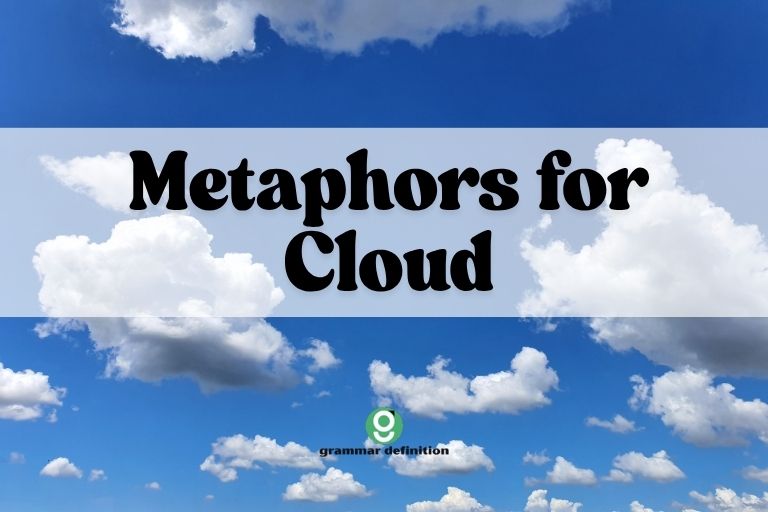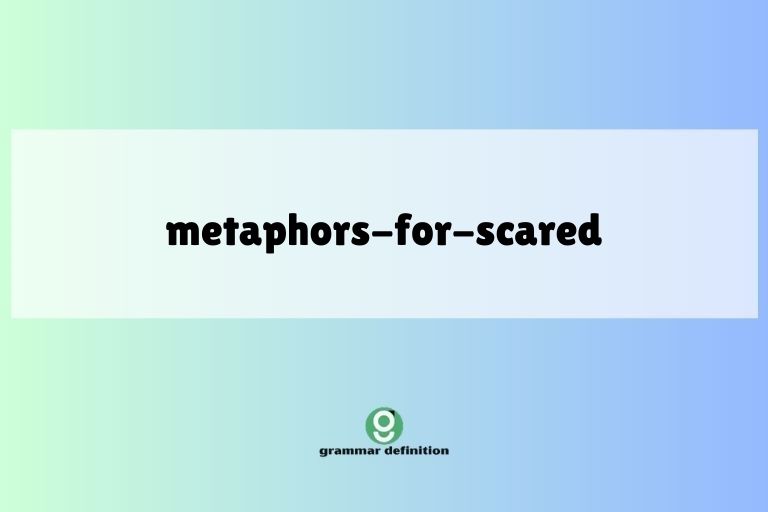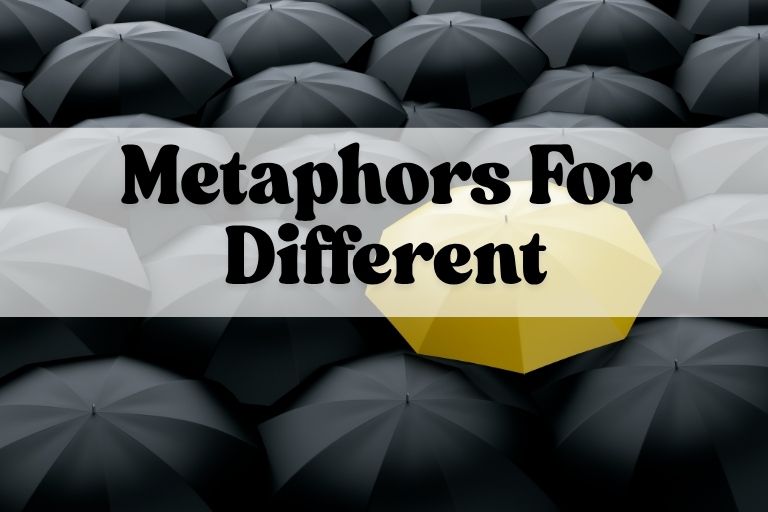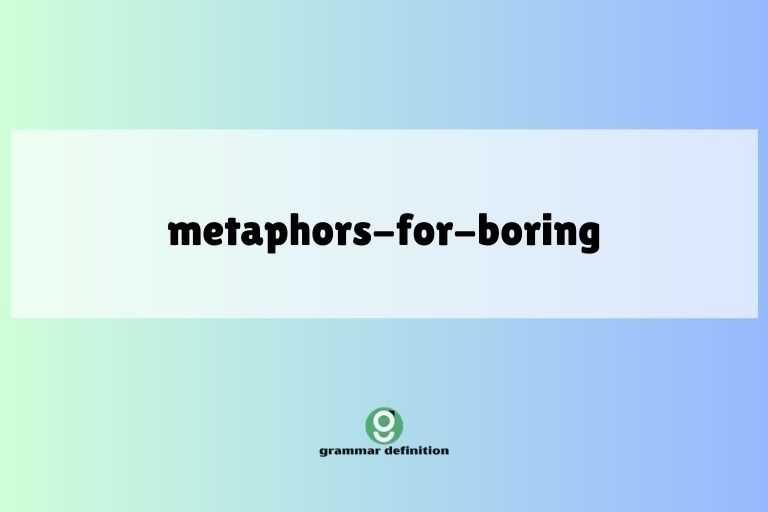Cloud Metaphors: A Comprehensive Guide to Figurative Language

Metaphors are powerful tools in the English language, allowing us to create vivid imagery and convey complex ideas in a succinct manner. When it comes to describing the ever-changing nature of clouds, metaphors are particularly effective.
Understanding how to use cloud metaphors not only enhances your writing and speaking skills but also deepens your appreciation of the beauty and complexity of the natural world. This article is designed for English language learners, writers, and anyone interested in exploring the expressive potential of metaphors.
It will provide a comprehensive overview of cloud metaphors, including their definition, structure, types, usage rules, common mistakes, and practice exercises.
By the end of this article, you will be equipped with the knowledge and skills to effectively use cloud metaphors in your own writing and conversations, adding depth, color, and creativity to your language.
Table of Contents
- Introduction
- Definition of Cloud Metaphors
- Structural Breakdown of Cloud Metaphors
- Types of Cloud Metaphors
- Examples of Cloud Metaphors
- Usage Rules for Cloud Metaphors
- Common Mistakes When Using Cloud Metaphors
- Practice Exercises
- Advanced Topics in Cloud Metaphors
- Frequently Asked Questions (FAQ)
- Conclusion
Definition of Cloud Metaphors
A metaphor is a figure of speech that directly compares two unlike things without using “like” or “as.” It asserts that one thing is another, creating a vivid and imaginative connection. Cloud metaphors, specifically, use the characteristics of clouds to describe something else, imbuing the subject with the qualities of clouds such as their shape, color, texture, movement, or emotional impact. These metaphors tap into our universal understanding of clouds and their associated feelings to create powerful imagery.
The function of cloud metaphors is multifaceted. They can simplify complex ideas, add emotional depth to descriptions, and create a more engaging and memorable experience for the reader or listener.
By drawing a parallel between a cloud and something else, the writer or speaker can evoke a sense of wonder, tranquility, or even foreboding, depending on the specific metaphor used.
Cloud metaphors are commonly found in literature, poetry, songs, and everyday conversation. They are particularly prevalent in descriptive writing, where the goal is to paint a picture with words and evoke a particular mood or atmosphere.
In poetry, cloud metaphors can add layers of meaning and symbolism, inviting the reader to interpret the poem on a deeper level. Even in casual conversation, cloud metaphors can add a touch of creativity and expressiveness to our language.
Structural Breakdown of Cloud Metaphors
A typical metaphor consists of two main elements: the tenor and the vehicle. The tenor is the subject being described, and the vehicle is the thing it’s being compared to. In the case of cloud metaphors, the vehicle is always a cloud or some aspect of clouds.
For example, in the metaphor “Her dreams were castles in the clouds,” the tenor is “her dreams,” and the vehicle is “castles in the clouds.” The metaphor suggests that her dreams are grand, imaginative, and perhaps unattainable, just like castles floating in the sky. The connection between the tenor and the vehicle is what creates the metaphorical meaning.
The effectiveness of a cloud metaphor depends on the strength and relevance of the connection between the tenor and the vehicle. A good cloud metaphor will resonate with the reader or listener, creating a clear and memorable image.
A weak or inappropriate metaphor, on the other hand, can be confusing or distracting.
Understanding the structure of a metaphor allows you to analyze and appreciate the nuances of figurative language. It also empowers you to create your own effective and imaginative cloud metaphors.
Types of Cloud Metaphors
Cloud metaphors can be categorized based on the specific aspect of clouds they emphasize. Here are some common types:
Shape and Size
These metaphors focus on the physical form and dimensions of clouds. They can describe something as being large and imposing like a cumulonimbus cloud, or small and delicate like a cirrus cloud.
Texture
These metaphors highlight the feel or appearance of cloud surfaces. Clouds can be fluffy, wispy, dense, or ragged, and these qualities can be used to describe other things.
Color
These metaphors use the colors of clouds to evoke certain moods or associations. White clouds might symbolize purity or innocence, while dark clouds might suggest sadness or impending doom.
Movement
These metaphors focus on how clouds move across the sky. They can describe something as being fast and fleeting, slow and ponderous, or unpredictable and erratic.
Emotional Tone
These metaphors use the overall feeling or atmosphere associated with clouds to describe something else. A bright, sunny day with fluffy clouds might evoke feelings of joy and optimism, while a stormy sky might create a sense of anxiety or fear.
Examples of Cloud Metaphors
Here are some examples of cloud metaphors, organized by category:
Shape and Size Examples
The following table provides examples of metaphors that use the shape and size of clouds to describe other things.
| Metaphor | Explanation |
|---|---|
| His ambition was a cumulonimbus, towering over all others. | His ambition was large, imposing, and potentially overwhelming. |
| Her hopes were cirrus clouds, delicate and easily scattered. | Her hopes were fragile and easily lost. |
| The problem loomed like a thunderhead, dark and threatening. | The problem was significant and caused worry. |
| The crowd was a shapeless cloud, drifting aimlessly through the streets. | The crowd lacked direction and purpose. |
| His dreams were castles in the clouds, grand but unattainable. | His dreams were imaginative but unrealistic. |
| The company’s debt was a gathering storm cloud. | The debt was accumulating and posed a threat. |
| Her laughter was a fluffy cloud, light and carefree. | Her laughter was joyful and unburdened. |
| The artist’s imagination was a boundless sky filled with endless clouds. | The artist had limitless creativity. |
| The politician’s promises were vaporous clouds, full of hot air. | The politician’s promises were insubstantial and unreliable. |
| The student’s understanding was a small, fleeting cloud on a vast horizon. | The student had a limited grasp of the subject. |
| The mountain peak was shrouded in clouds, a mysterious giant. | The mountain was partially hidden and awe-inspiring. |
| The project’s budget was a swollen rain cloud, ready to burst. | The project’s budget was excessive and unsustainable. |
| His ego was a towering thundercloud, full of pride and arrogance. | His ego was inflated and overbearing. |
| The secret hung in the air like a dense fog cloud. | The secret was heavy and pervasive. |
| The possibilities stretched out like an endless, cloud-dotted sky. | The possibilities were numerous and varied. |
| Her spirit was a high-flying, sunlit cloud. | Her spirit was optimistic and uplifting. |
| The challenge before them was a massive, dark cloud on the horizon. | The challenge was formidable and daunting. |
| Their love story was a fleeting summer cloud, beautiful but short-lived. | Their love story was lovely, but temporary. |
| The artist’s vision was as expansive as a sky full of clouds. | The artist’s vision was extensive and comprehensive. |
| The news hit them like a thundercloud, sudden and shocking. | The news was unexpected and devastating. |
| His anger was a dark, brooding cloud. | His anger was intense and ominous. |
| The child’s imagination was a playful cloud, constantly changing shape. | The child’s imagination was creative and dynamic. |
| The future seemed like a distant, hazy cloud. | The future was uncertain and unclear. |
| The memories floated like puffy clouds in the sky of her mind. | The memories were gentle and pleasant. |
Texture Examples
The following table provides examples of metaphors that use the texture of clouds to describe other things.
| Metaphor | Explanation |
|---|---|
| Her voice was as soft as a cloud’s gentle caress. | Her voice was gentle and soothing. |
| The fabric was as smooth as a cloud’s surface. | The fabric was exceptionally soft and pleasant to touch. |
| His ideas were as nebulous as a foggy cloud. | His ideas were vague and unclear. |
| The snow was as light as a cloud’s breath. | The snow was extremely delicate and weightless. |
| The cotton candy was as fluffy as a cumulus cloud. | The cotton candy was light, airy, and soft. |
| Her skin felt like the softest cloud. | Her skin was incredibly smooth and delicate. |
| The mist hung like a veil of cloud. | The mist was light and ethereal, partially obscuring the view. |
| The atmosphere was thick as a storm cloud. | The atmosphere was tense and heavy with anticipation. |
| His words were like wisps of clouds, disappearing quickly. | His words were fleeting and insubstantial. |
| The feeling of dread was as heavy as a rain cloud. | The feeling of dread was oppressive and overwhelming. |
| Her touch was as light as a cloud’s shadow. | Her touch was barely perceptible and gentle. |
| The secret was shrouded in a cloud of mystery. | The secret was concealed and difficult to uncover. |
| The dust particles hung in the air like a hazy cloud. | The dust particles created a slight and diffused obscurity. |
| His memories were fragmented, like torn clouds in the sky. | His memories were incomplete and scattered. |
| The rumor spread like a dark cloud, tainting everything it touched. | The rumor had a negative impact and affected many things. |
| The smoke billowed like a massive, sooty cloud. | The smoke was thick, dark, and expansive. |
| Her sadness enveloped her like a heavy, gray cloud. | Her sadness was overwhelming and oppressive. |
| The uncertainty lingered like a persistent, low-hanging cloud. | The uncertainty was ongoing and difficult to ignore. |
| His apologies were as insincere as a cloud made of smoke. | His apologies were false and lacked genuine remorse. |
| The city was blanketed in a smoggy cloud. | The city was covered in thick, polluted air. |
| The silence was thick and heavy, like a storm cloud about to break. | The silence was tense and filled with unspoken emotions. |
| Her laughter was as light and airy as a cloud. | Her laughter was joyful and carefree. |
| The fog rolled in, thick as a woolly cloud. | The fog was dense and substantial. |
| His excuse was flimsy, like a cloud of cotton candy. | His excuse was weak and unconvincing. |
Color Examples
The following table provides examples of metaphors that use the color of clouds to describe other things.
| Metaphor | Explanation |
|---|---|
| Her mood was as gray as a storm cloud. | Her mood was gloomy and depressed. |
| His future looked as dark as a thundercloud. | His future appeared bleak and uncertain. |
| Her innocence was as white as a cloud. | Her innocence was pure and untainted. |
| His anger was as red as a sunset cloud. | His anger was intense and passionate. |
| The sky was painted with clouds of gold. | The sky was filled with beautiful, golden-colored clouds. |
| Her dreams were as bright as clouds at dawn. | Her dreams were hopeful and promising. |
| The truth was hidden behind a gray cloud of lies. | The truth was obscured by deception. |
| His thoughts were as clear as a blue sky after the clouds had passed. | His thoughts were lucid and untroubled. |
| The situation was as murky as a clouded sky. | The situation was confusing and unclear. |
| Her aura was as radiant as a sunlit cloud. | Her presence was bright and uplifting. |
| The memory was as faded as a cloud at dusk. | The memory was distant and indistinct. |
| His heart was as black as a storm cloud. | His heart was filled with darkness and negativity. |
| The opportunity was as golden as a sunset cloud. | The opportunity was valuable and promising. |
| Her spirit was as vibrant as a rainbow after the rain clouds. | Her spirit was full of life and energy after a difficult time. |
| The secret was as dark as a night cloud. | The secret was sinister and concealed. |
| His smile was as warm as a sunbeam breaking through the clouds. | His smile was comforting and cheerful. |
| The city lights glowed like scattered, golden clouds against the night sky. | The city lights created a beautiful and luminous effect. |
| Her wisdom shone like a silver lining in a dark cloud. | Her wisdom provided hope and guidance during a difficult time. |
| The past was as gray as a clouded memory. | The past was somber and indistinct. |
| His eyes were as blue as the sky after the clouds had cleared. | His eyes were clear and bright. |
| Her dress was the color of a twilight cloud, a soft, dusky rose. | Her dress was a subtle and beautiful shade. |
| The wine was the color of a sunset cloud, rich and vibrant. | The wine had a beautiful and intense color. |
| Her optimism was like a bright white cloud, standing out against the gray. | Her optimism was noticeable and uplifting. |
| The lie hung in the air, a dark cloud over their friendship. | The lie threatened to damage their relationship. |
Movement Examples
The following table provides examples of metaphors that use the movement of clouds to describe other things.
| Metaphor | Explanation |
|---|---|
| His thoughts drifted like clouds across the sky. | His thoughts wandered aimlessly. |
| Time passed like clouds in a gentle breeze. | Time moved slowly and peacefully. |
| Her worries dissipated like clouds in the sun. | Her worries disappeared quickly and easily. |
| Opportunities floated by like clouds. | Opportunities presented themselves but were not always seized. |
| Ideas swirled like clouds in a storm. | Ideas were chaotic and overwhelming. |
| His anger exploded like a thundercloud bursting with rain. | His anger erupted suddenly and intensely. |
| Memories faded like clouds at sunset. | Memories became less distinct over time. |
| Her dreams soared like clouds on the wind. | Her dreams were ambitious and unrestrained. |
| The rumor spread like wildfire, a cloud of smoke billowing across the town. | The rumor spread rapidly and uncontrollably. |
| His hopes evaporated like clouds on a hot day. | His hopes disappeared quickly and completely. |
| The protesters marched like a gathering storm cloud. | The protesters moved with purpose and intensity. |
| Her fears loomed like a dark cloud approaching. | Her fears were growing and becoming more imminent. |
| The dancers moved like clouds in a graceful ballet. | The dancers moved fluidly and elegantly. |
| His ambitions were as fluid as clouds, ever-changing and adapting. | His ambitions were flexible and open to new possibilities. |
| The project’s progress stalled, like a cloud caught in a windless sky. | The project’s progress was halted and motionless. |
| Her tears fell like rain from a heavy cloud. | Her tears were abundant and sorrowful. |
| The children scattered like clouds before a storm. | The children dispersed quickly and nervously. |
| His influence waned, like a cloud thinning in the sky. | His influence diminished over time. |
| The crowd surged forward like a wave, a dark cloud of humanity. | The crowd moved forcefully and powerfully. |
| Her secrets swirled around her like a dark, impenetrable cloud. | Her secrets were confusing and difficult to understand. |
| The economy fluctuated like clouds in a turbulent sky. | The economy was unstable and unpredictable. |
| His arguments were as shifting as clouds, never staying in one place. | His arguments were inconsistent and unreliable. |
| The opportunities passed quickly, like clouds blown by the wind. | The opportunities were fleeting and required immediate action. |
| Her doubts hovered like a dark cloud over her decision. | Her doubts were persistent and troubling. |
Emotional Tone Examples
The following table provides examples of metaphors that use the emotional tone associated with clouds to describe other things.
| Metaphor | Explanation |
|---|---|
| Her happiness was a sunny sky with fluffy clouds. | Her happiness was bright, joyful, and carefree. |
| His sadness was a dark and stormy cloud. | His sadness was overwhelming and depressing. |
| Their love was a peaceful sunset with gentle clouds. | Their love was serene, comforting, and beautiful. |
| The atmosphere was as heavy as a storm cloud. | The atmosphere was tense and foreboding. |
| Hope emerged like a silver lining in a dark cloud. | Hope appeared during a difficult or challenging time. |
| Despair settled over him like a dense fog cloud. | Despair enveloped him completely. |
| The future seemed bright, like a sky full of promise after the clouds had cleared. | The future appeared hopeful and optimistic. |
| The weight of the world felt like a thundercloud on his shoulders. | The burdens he carried were heavy and overwhelming. |
| Relief washed over her like a gentle rain after a long drought, the clouds finally breaking. | Relief was deeply satisfying and restorative. |
| The memory cast a shadow like a cloud passing over the sun. | The memory created a feeling of sadness or regret. |
| Her spirit was uplifted, like a cloud floating freely in the sky. | Her spirit was light, unburdened, and joyful. |
| The challenge seemed insurmountable, like a towering storm cloud. | The challenge was daunting and overwhelming. |
| Peace descended like a soft cloud, enveloping the weary travelers. | Peace was comforting and restorative. |
| Fear gripped him like a cold, dark cloud. | Fear was paralyzing and oppressive. |
| Her resilience shone like a sunbeam through the clouds. | Her resilience was strong and inspiring. |
| Regret lingered like a heavy cloud, obscuring the joy of the moment. | Regret diminished the happiness of the present. |
| The anticipation hung in the air, thick as a gathering storm cloud. | The anticipation was palpable and intense. |
| Their friendship was a bright sky, even when small clouds appeared. | Their friendship was strong and resilient. |
| Loneliness enveloped him like a gray cloud, isolating him from the world. | Loneliness was pervasive and isolating. |
| Her courage was a burst of sunlight, breaking through the clouds of doubt. | Her courage was empowering and inspiring. |
| The disappointment settled like a shroud, a dark cloud over their hopes. | The disappointment was profound and discouraging. |
| His determination was unwavering, like a steady wind pushing the clouds forward. | His determination was strong and persistent. |
| The uncertainty loomed like a threatening cloud, casting a shadow over their plans. | The uncertainty made their plans seem risky and uncertain. |
| Her gratitude was as pure as a blue sky after a storm, the clouds having cleared. | Her gratitude was genuine and heartfelt. |
Usage Rules for Cloud Metaphors
While metaphors are inherently creative, there are some guidelines to follow to ensure clarity and effectiveness:
- Relevance: The connection between the cloud and the subject should be clear and relevant. Choose cloud characteristics that genuinely enhance the description.
- Originality: Strive for fresh and imaginative metaphors. Avoid clichés like “head in the clouds” unless you’re using them ironically.
- Consistency: Maintain a consistent tone and image throughout the metaphor. Mixing different cloud types or characteristics can create a confusing or jarring effect.
- Clarity: Ensure that the metaphor is easily understood by your audience. Avoid overly obscure or complex comparisons.
- Context: Consider the context in which you’re using the metaphor. A cloud metaphor that works well in a poem might not be appropriate for a business report.
Exceptions: Sometimes, breaking the rules can create a powerful effect. A mixed metaphor, for example, can be used intentionally to create humor or highlight a contradiction. However, it’s important to understand the rules before you break them.
Common Mistakes When Using Cloud Metaphors
Here are some common mistakes to avoid when using cloud metaphors:
| Mistake | Incorrect Example | Correct Example |
|---|---|---|
| Cliché: Using overused and unoriginal metaphors. | He had his head in the clouds. | His dreams were castles in the clouds, grand but distant. |
| Mixed Metaphor: Combining unrelated images or ideas. | The project was a gathering storm cloud, but we nipped it in the bud. | The project was a gathering storm cloud, threatening to derail our progress. |
| Inappropriate Metaphor: Using a metaphor that doesn’t fit the context or tone. | The company’s profits soared like a thundercloud. | The company’s profits soared like a cumulus cloud on a sunny day. |
| Unclear Metaphor: Using a metaphor that is too obscure or confusing. | His emotions were like altostratus clouds. | His emotions were as layered and complex as a sky filled with altostratus clouds. |
| Overuse of Metaphors: Using too many metaphors in a short space, which can become overwhelming. | The day dawned like a promise, the sky a canvas of hope. Clouds, like dreams, drifted lazily, each a whisper of tomorrow. | The day dawned with a promising sky, clouds drifting lazily like dreams. |
Practice Exercises
Test your understanding of cloud metaphors with these exercises:
Exercise 1: Identifying Cloud Metaphors
Identify the cloud metaphor in each sentence and explain what it means.
| # | Sentence | Answer |
|---|---|---|
| 1 | Her worries dissipated like clouds in the sun. | Metaphor: “Worries dissipated like clouds in the sun.” Meaning: Her worries disappeared quickly and easily. |
| 2 | His anger was as dark as a thundercloud. | Metaphor: “Anger was as dark as a thundercloud.” Meaning: His anger was intense and ominous. |
| 3 | The future seemed like a distant, hazy cloud. | Metaphor: “Future seemed like a distant, hazy cloud.” Meaning: The future was uncertain and unclear. |
| 4 | Opportunities floated by like clouds. | Metaphor: “Opportunities floated by like clouds.” Meaning: Opportunities presented themselves but were not always seized. |
| 5 | Her voice was as soft as a cloud’s gentle caress. | Metaphor: “Voice was as soft as a cloud’s gentle caress.” Meaning: Her voice was gentle and soothing. |
| 6 | The secret hung in the air like a dense fog cloud. | Metaphor: “Secret hung in the air like a dense fog cloud.” Meaning: The secret was heavy and pervasive. |
| 7 | His dreams were castles in the clouds. | Metaphor: “Dreams were castles in the clouds.” Meaning: His dreams were imaginative but unrealistic. |
| 8 | The atmosphere was thick as a storm cloud. | Metaphor: “Atmosphere was thick as a storm cloud.” Meaning: The atmosphere was tense and heavy with anticipation. |
| 9 | Her mood was as gray as a storm cloud. | Metaphor: “Mood was as gray as a storm cloud.” Meaning: Her mood was gloomy and depressed. |
| 10 | His thoughts drifted like clouds across the sky. | Metaphor: “Thoughts drifted like clouds across the sky.” Meaning: His thoughts wandered aimlessly. |
Exercise 2: Creating Cloud Metaphors
Complete the following sentences by adding a cloud metaphor.
| # | Sentence | Possible Answer |
|---|---|---|
| 1 | Her laughter was as light as __________. | Her laughter was as light as a summer cloud. |
| 2 | The problem loomed like __________. | The problem loomed like a gathering storm cloud. |
| 3 | His ideas were as nebulous as __________. | His ideas were as nebulous as a foggy cloud. |
| 4 | Time passed like __________. | Time passed like clouds in a gentle breeze. |
| 5 | Her innocence was as white as __________. | Her innocence was as white as a cloud. |
| 6 | The opportunity was as golden as __________. | The opportunity was as golden as a sunset cloud. |
| 7 | His anger exploded like __________. | His anger exploded like a thundercloud bursting with rain. |
| 8 | Her worries dissipated like __________. | Her worries dissipated like clouds in the sun. |
| 9 | The mountain peak was shrouded in __________. | The mountain peak was shrouded in clouds, a mysterious giant. |
| 10 | The news hit them like __________. | The news hit them like a thundercloud, sudden and shocking. |
Exercise 3: Completing the Metaphor
Provide a short explanation for the following cloud metaphors.
| # | Metaphor | Explanation |
|---|---|---|
| 1 | His ambition was a cumulonimbus, towering over all others. | His ambition was expansive and imposing. |
| 2 | Her hopes were cirrus clouds, delicate and easily scattered. | Her hopes were fragile and easily lost. |
| 3 | The company’s debt was a gathering storm cloud. | The debt was accumulating and posed a threat. |
| 4 | The artist’s imagination was a boundless sky filled with endless clouds. | The artist had limitless creativity. |
| 5 | The silence was thick and heavy, like a storm cloud about to break. | The silence was tense and filled with unspoken emotions. |
| 6 | His influence waned, like a cloud thinning in the sky. | His influence diminished over time. |
| 7 | The challenge seemed insurmountable, like a towering storm cloud. | The challenge was daunting and overwhelming. |
| 8 | The memory cast a shadow like a cloud passing over the sun. | The memory created a feeling of sadness or regret. |
| 9 | The situation was as murky as a clouded sky. | The situation was confusing and unclear. |
| 10 | Loneliness enveloped him like a gray cloud, isolating him from the world. | Loneliness was
pervasive and isolating. |
Advanced Topics in Cloud Metaphors
For those looking to deepen their understanding and usage of cloud metaphors, here are some advanced topics:
Extended Cloud Metaphors
An extended metaphor is a metaphor that is developed over several lines or even an entire piece of writing. Instead of a brief comparison, the writer sustains the metaphorical connection, exploring various aspects of the relationship between the tenor and the vehicle.
With cloud metaphors, this might involve describing a complex emotional state by continually referencing different types of clouds and their changing behavior.
For example, instead of simply saying “Her sadness was a dark cloud,” you could write:
“Her sadness began as a small, gray cloud on the horizon, barely noticeable at first. But it grew, slowly and steadily, until it became a towering thunderhead, filling the sky with its darkness.
The rain poured down, a torrent of tears that threatened to wash away everything in its path. The wind howled, a symphony of despair that echoed through her soul.
And then, just as suddenly as it had begun, the storm passed, leaving behind a trail of wreckage and a sky still heavy with the memory of the clouds.”
This extended metaphor uses multiple cloud-related images to convey the depth and intensity of her sadness.
Avoiding Mixed Metaphors with Clouds
A mixed metaphor is a combination of two or more incompatible metaphors in a single expression. This can create a confusing or even humorous effect, but it’s generally best to avoid mixed metaphors in formal writing.
When using cloud metaphors, be careful not to combine them with other unrelated metaphors.
For example, the sentence “The project was a gathering storm cloud, but we nipped it in the bud” is a mixed metaphor because it combines the image of a storm cloud with the image of nipping a bud. A better sentence would be “The project was a gathering storm cloud, threatening to derail our progress.”
To avoid mixed metaphors, make sure that all the images in your metaphor are consistent and logically related.
Subtle and Implied Cloud Metaphors
Not all metaphors are explicit. Sometimes, a writer will use a subtle or implied metaphor, where the comparison is not directly stated but rather suggested through imagery and language.
This can be a more sophisticated and nuanced way of using figurative language.
For example, instead of saying “He was feeling down,” you could write “A shadow passed over his face,” subtly invoking the image of a cloud obscuring the sun.
Subtle metaphors require a careful choice of words and attention to detail. They can be particularly effective in creating a mood or atmosphere without being overly explicit.
Frequently Asked Questions (FAQ)
Q: Are cloud metaphors only used to describe negative emotions?
A: No, cloud metaphors can be used to describe a wide range of emotions, both positive and negative. Sunny skies with fluffy clouds can represent happiness, while dark storm clouds can represent sadness or fear.
Q: Can I use cloud metaphors in technical writing?
A: While metaphors are generally more common in creative writing, they can be used sparingly in technical writing to explain complex concepts or make the text more engaging. However, it’s important to use them carefully and ensure that they are clear and appropriate for the audience.
Q: How can I come up with original cloud metaphors?
A: To come up with original cloud metaphors, try to think about the specific qualities of clouds that you want to emphasize. Consider their shape, texture, color, movement, and emotional associations.
Then, brainstorm different ways to connect those qualities to the subject you’re describing.
Q: What is the difference between a simile and a metaphor?
A: A simile is a comparison that uses “like” or “as,” while a metaphor is a direct comparison that does not use “like” or “as.” For example, “Her voice was like a soft cloud” is a simile, while “Her voice was a soft cloud” is a metaphor.
Conclusion
Cloud metaphors are a versatile and powerful tool for enhancing your writing and speaking skills. By understanding the structure, types, and usage rules of cloud metaphors, you can effectively use them to create vivid imagery, add emotional depth, and engage your audience.
Whether you’re writing a poem, a story, or a simple conversation, cloud metaphors can help you express yourself with greater creativity and expressiveness. So, look up at the sky, observe the clouds, and let your imagination soar!






